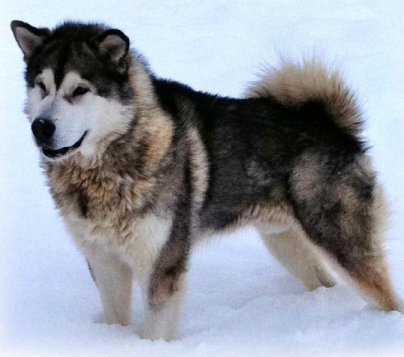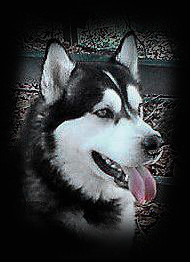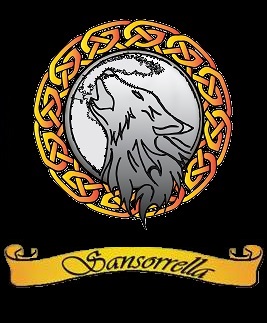
Alaskan Malamute

 "Gizmo" - Suroketa Gizmo's Lyrics At Altomals |

|
A BRIEF HISTORY OF THE Alaskan Malamute The Alaskan Malamute evolved from the ancient dogs that accompanied prehistoric man on his migrations from Asia across the Arctic to Greenland and back. These migrations covered thousands of years. They produced a natural evolution of species that varied from the long coated varieties found in Greenland to the lesser coated, longer legged varieties found in the forest and lake areas of Canada. Early Russian and English explorers often reported a superior and better-kept type of work dog used by the “Mahlemut” (Malemiut, Mahlmuit, Malemuit) tribes around the Norton Sound area of Alaska. They were less “wild”, more tractable and capable of an enormous amount of work. It must be kept in mind that these were work animals. They were used in hunting seals, were set loose in packs to course the polar bear, to haul heavy sledges, or pack supplies. Although treated with fondness and exceptional care, here were no room for “pets” on the cruel ice packs and tundra. With the Gold Rush, the demands for pack and sled dogs brought to Alaska all types of breeds that could survive the weather. Soon, especially near the populated areas, these dogs were quite a mixture of breeds and quality. One had to travel many days inland, out into the gold country to find any semblance of the original Alaskan sled dog. Due to their relative isolation, the dogs of the “Mahlemut” remained fairly “pure”, but they too suffered from the inroads of civilisation. Chinook Kennels, established by Arthur T Walden, and later by Milton and Eva Seeley in New Hampshire, was one of the main sources for sled dogs used in the Byrd Antarctic expeditions in the early thirties. The Seeleys began a programme to reproduce those dogs that were typical of the dogs found in the Norton Sounds area. “Kotzebue” applies to the main strain of Alaskan Malamutes at Chinook Kennels established by the Seeleys. A slightly different strain was developed by Paul Voelker Snr., and Paul Voelker Jnr., with dogs they brought from Alaska in the early 1900’s, and later in the 1920’s. These were generally known at the “M’Loot” strain, named after the kennel established by the Voelkers. Some of these dogs saw service in World War 1 and World War 2, and with Admiral Byrd’s second expedition. Ralph and Marchetta Schmitt of Silver Star Kennels purchased some of the Voelkers dogs to further establish the “M’Loot” strain. These two terms “Kotzebue” and “M’Loot” are often used to describe the genetic background of the present day Malamute whether the current dogs resemble their ancestors or not.
Reprinted by kind permission of Wendy Willhauck, AMCA Judges Education Co-ordinator |

|
A few Malamutes are still in use as sled dogs for personal travel, hauling freight, or helping move heavy objects; some however are used for the recreational pursuit of sledding, also known as mushing, as well as for skijoring, bikejoring, carting, and canicross. However, most Malamutes today are kept as family pets or as show or performance dogs in weight pulling, dog agility, or packing. The Malamute is generally slower in long-distance dogsled racing against smaller and faster breeds and their working usefulness is limited to freighting or travelling over long distances at a far slower rate than that required for racing. They can also help move heavy objects over shorter distances. The Malamute retains more of its original form and function than many other modern breeds. If a dog owner cannot cope with a dog that will not comply with the owner's every command, a more compliant breed should be selected. This dog has a long genetic foundation of living in the harshest environment imaginable and many of its behaviours are evolved to conform with "survival of the fittest." Independence, resourcefulness and primitive behaviours are common in the breed. Because of their intelligence they can be one of the most difficult dogs to train. However, if the trainer understands the malamute and how to keep them motivated, success is within reach. There is reason to believe that Alaskan Malamutes sometimes cope poorly with smaller animals, including other canines; this has been difficult to document in detail beyond observational data. Many Malamute owners have observed this behaviour with smaller animals, though some might speculate this is due to the Malamute's uniquely divergent ancestry, at some points cross-breeding with wolves. Due to their naturally evolved beginnings, the Malamute tends to have a heightened prey drive when compared to some other breeds of dog. So while Malamutes are, as a general rule, particularly amiable around people and can be taught to tolerate other pets, it is necessary to be mindful of them around smaller animals and children. Malamutes are quite fond of people, a trait that makes them particularly sought-after family dogs. Malamutes are nimble around furniture and smaller items, making them ideal house dogs, provided they get plenty of time outdoors meeting their considerable exercise requirements. If they are year-round outdoor dogs, letting them play in a baby pool filled with cold water in summer keeps them cool. In the winter, they love snow. The majority of Malamutes are fairly quiet dogs, seldom barking like most other dog breeds. When a malamute does vocalize, more often than not they tend to "talk" by vocalizing a "woo woo" sound. They may howl like wolves and for the same reason.
|
 "Storm" - Muskeg Cherokee Ghost |
"In all things of nature there is something of the marvellous" Aristotle


![]() Sansorrella 2010 All rights reserved
Sansorrella 2010 All rights reserved